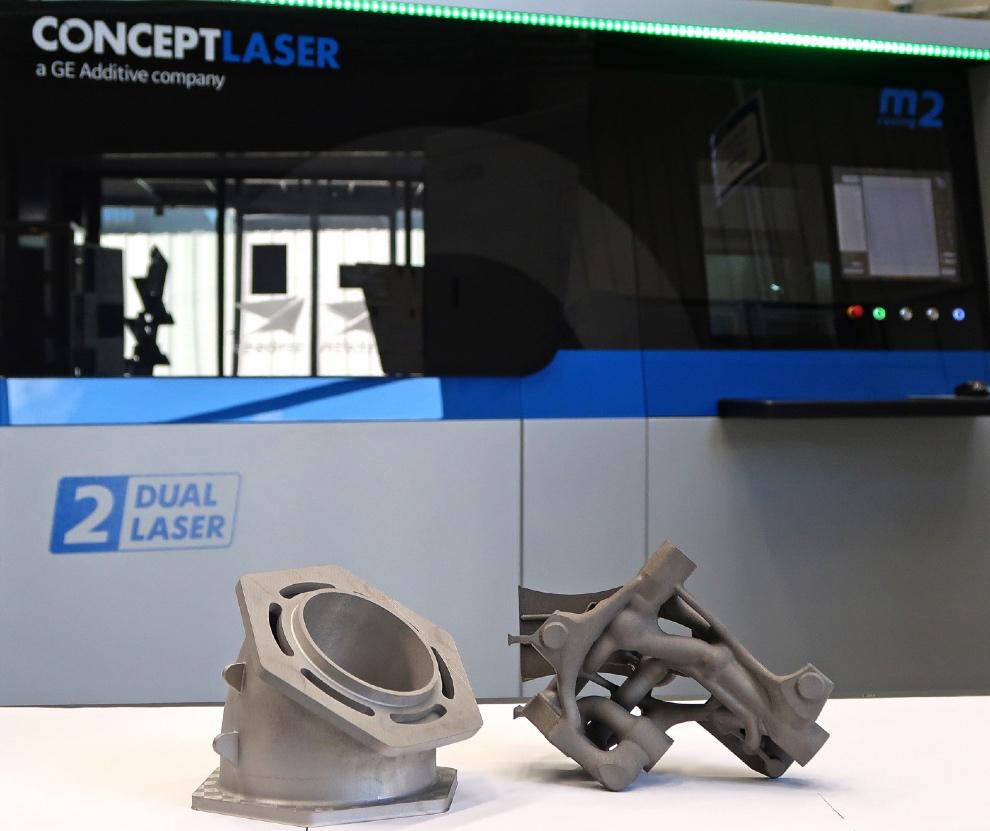- FMA
- The Fabricator
- FABTECH
- Canadian Metalworking
Our Publications
Categories
- Additive Manufacturing
- Aluminum Welding
- Arc Welding
- Assembly and Joining
- Automation and Robotics
- Bending and Forming
- Consumables
- Cutting and Weld Prep
- Electric Vehicles
- En Español
- Finishing
- Hydroforming
- Laser Cutting
- Laser Welding
- Machining
- Manufacturing Software
- Materials Handling
- Metals/Materials
- Oxyfuel Cutting
- Plasma Cutting
- Power Tools
- Punching and Other Holemaking
- Roll Forming
- Safety
- Sawing
- Shearing
- Shop Management
- Testing and Measuring
- Tube and Pipe Fabrication
- Tube and Pipe Production
- Waterjet Cutting
Industry Directory
Webcasts
Podcasts
FAB 40
Advertise
Subscribe
Account Login
Search
GE Additive customers take to metal AM
Two European companies rely on metal 3D printers to break new ground for aerospace and medical applications
- November 29, 2020
- Article
- Additive Manufacturing

AEROTEC’s customer, Airbus, validated the process of using multiple lasers to build one component. GE Additive
GE Additive has joined forces with two European manufacturers—Premium AEROTEC and Tsunami Medical—to additively manufacture critical-application parts.
Serially produced aero parts
According to a GE-issued press release, an outgrowth of its ongoing efforts with the German company AEROTEC has led to the serial production of metal 3D-printed components. Since 2019, when process qualification for titanium components on a GE Additive Concept Laser M2 multilaser system was successfully validated, the focus of the GE/AEROTEC collaboration has been on raising productivity.
Until recently, though, qualification had been limited to the parallel assembly of several components in the build chamber of the system, with one laser being assigned to each part. For those components that occupy much of the available space in the machine, due to their dimensions, productivity could not be increased by applying several lasers in parallel.
However, this limitation was removed recently after AEROTEC’s customer, Airbus, validated the process of using multiple lasers to build one component. The process-critical area is where the exposure zones of the lasers—known as the “stitching zone”—overlap.
The technology allows AEROTEC to “achieve a homogeneous, quasi-isotropic structure with excellent material properties in the overlap area, which does not show any discernible differences from the previous quality standard,” said AEROTEC’s project manager, Thomas Bielefeld. “At the same time … we have succeeded in increasing productivity in component production by more than 30%.”
AEROTEC plans to use the newly validated system to produce components for the Airbus A320 family of aircraft. The Concept Laser M2 is a dual-laser system with a build volume of 250 by 250 by 350 mm3 and a 3D optic with variable spot diameter.
Ready-to-implant implants
Since its founding more than 20 years ago, Tsunami Medical has evolved to meet the needs of the ever-changing global spinal implants market. At the heart of its evolution, says Tsunami, is a robust innovation strategy that embraces and integrates new technologies, such as AM.
The company purchased its first two GE Additive direct metal laser melting (DMLM) systems in 2015. Today, the Italian company remains focused on the spinal implant sector and, to date, has additively manufactured more than 50,000 pieces for its global customers.

The Giglio 3D-printed spinal implant consists of an interspinal spacer device and the necessary tools for its positioning and fixing within a minimally invasive operation. Tsunami Medical
The technology of spinal cage implants has evolved quickly in a relatively short period of time. Compared to early PEEK-based implants, for instance, metal 3D-printed devices now make it possible to calibrate the mechanical properties, elastic modulus, and rigidity of a device. The technology also gives designers the freedom to create open structures, which almost replicate the porous structures of trabecular bone.
Another advantage of additively manufactured structures is that they can be incorporated into the shape of the implant and produced in one production step, eliminating the need for additional coating. This allows for the design of porous structures featuring customized conformations of pores, thicknesses, and overall porosity.
The company’s latest breakthrough is the Giglio Interspinal Fusion System, intended to allow the printing of implants that are almost ready for use straight from a metal AM machine. Giglio consists of an interspinal spacer device and the necessary tools for its positioning and fixing during a minimally invasive operation.
“DMLM helps us achieve the accuracy, complexity, and functional integration we are striving for,” said Tsunami’s founder and general manager, Stefano Caselli. “The implant comes out of the machine with an optimized 20-unit printing cycle, and without the need for support structures. It is already fully assembled and, except for final polishing, requires no postprocessing.”
Click on the following links to learn more about the Premium AEROTEC/GE and Tsunami Medical/GE projects.
About the Publication
- Podcasting
- Podcast:
- The Fabricator Podcast
- Published:
- 04/16/2024
- Running Time:
- 63:29
In this episode of The Fabricator Podcast, Caleb Chamberlain, co-founder and CEO of OSH Cut, discusses his company’s...
- Trending Articles
- Industry Events
16th Annual Safety Conference
- April 30 - May 1, 2024
- Elgin,
Pipe and Tube Conference
- May 21 - 22, 2024
- Omaha, NE
World-Class Roll Forming Workshop
- June 5 - 6, 2024
- Louisville, KY
Advanced Laser Application Workshop
- June 25 - 27, 2024
- Novi, MI


























